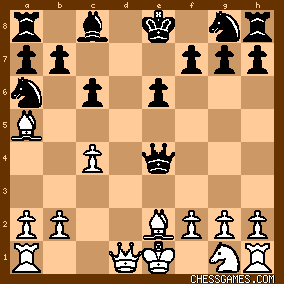|
1.d5 d5 2.d4 e6 3.Nc3 c6 4.e4 
click for larger view
Opening Explorer (577 games)
http://www.chessgames.com/perl/ches... Black plays this way in order to avoid the Exchange Variation of the Slav, on the one hand, and on the other, the necessity to learn a second opening, the Nimzo-Indian, which arises if Black begins instead with 1.d4 Nf6 2.c4 e6 and then White plays 3.Nc3 - making the desired Semi-Slav unlikely. Mind you, Sadler (Queen's Gambit Declined, Everyman, 2000) warns "do you want to spend a lifetime learning the 4.e4 Marshall Gambit?" indicating that not a lot of work will necessarily be saved by making this choice. Still, in The Complete Semi-Slav (Batsford, 1994) Peter Wells says that "personally, I enjoy playing both sides of this fascinating gambit" and it was recommended, for instance, in Larry Kaufman's well-received repertoire book The Chess Openings In Black And White (Random House, 2004). It's one of those openings that you feel you'd like to avoid when playing on the other side, but seem somehow not quite entirely trustworthy as a part of one's own repertoire: Kaufman considers his opening recommendations to be "fully respectable among strong grandmasters" but it certainly doesn't seem to crop up very much above 2650 level. Never mind, that's a higher rating than any opponent I've ever played (or so I believe - what was Tony Miles' rating when I played him in Wolverhampton about twenty years ago?) but even so, I do get the feeling, as with the Benko Gambit or the Chigorin, that one day somebody, or something, is going to find a clear-cut refutation. Often, when White goes 4.e4 and thus takes up the gauntlet, play continues <4...dxe4 5.Nxe4 Bb4+ 6.Bd2 Qxd4 7.Bxb4 Qxe4+ 8.Be2 Na6 9.Bc3> 
click for larger viewOpening Explorer (37 games) and now it used to be standard to play <9...Ne7> which was considered absolutely fine for Black until a 1993 last-round interzonal game Lautier v M.Gurevich Lautier vs M Gurevich, 1993, given below, in which Black was dramatically demolished. (It's still played, but <9...f6> has attracted some attention given that Lautier's plan still seems strong.) Lautier vs M Gurevich, 1993 now continued <10.Bxg7 Rg8 11.Bf6> and now <11...Qf4>, which used to be thought good, was burned up after <12.Bc3! Rxg2 13.Nf3 f6 14.Qd2!> when the exchange benefitted White as the queen's absence made it hard for Black to defend his many weaknesses. I'm not going to swamp this post with theory - Wells is a good place to look it up and if you do, you'll see he doesn't rate the alternative 11..Rg6 very highly. But Scherbakov thinks it's playable and follows a 1995 game he played against Berg which went 12.Bc3 Qxg2 13.Qd2 Qxh1 14.O-O-O Nd5 (not my normal style, this line) 15.Nf3 Qg2 16.cxd5 cxd5 17.Ne5 Bd7 18.Qf4 Rg7 19.Nxd7 and now instead of 19...Kxd7, which he played, he recommends 19...Qg5 20.Nf6+ Ke7 21.Qxg5 Rxg5 and claims that
"Black's position is quite acceptable..."
"...since after 22.Nxh7 Rf5 23.Bd4 f6..."
"...White should be careful about his knight."
As I say, I like Scherbakov's work, but in this instance I wonder how far he's gone to check his conclusion: if there was an Informator symbol for "Jimmy Hill" I'd insert one here. I don't believe it and neither does Rybka, which likes 24.Rg1! and likes it a lot. The point is that if the king is driven away from the f6 pawn then the knight can take it with impunity and doesn't have to be careful at all. Black's obvious response is 24...e5 which shields the pawn from the bishop and therefore allows the rook to defend it, but after 25.Rg7+ Kd6 it turns out that White's bishops drive the rook away: 26.Bg4 Rf4 27.Be3 and it has to move from the f-file. So 27...Rc4+ 28.Kd2: and the best I can produce on Black's behalf is "fighting for a draw". Those bishops are really pretty good. That's not a forced line but I've been unable to find any deviations which help the Black cause - Black can take a queenside pawn, or play an early ...Rc8+, or try ...Rh8 attempting to tie up the White pieces a little, but in every case it looks like Black's position is under too much pressure to be held. Now it's true that this is Rybka-led analysis and that computers aren't always the best judges of positions in the Marshall - as you'll see if you use one to play through the earlier moves and watch the evaluation swing about. But still: in the absence of any contradictory evidence the position after 23...f6 (though not the Gambit as such, of course) looks like a busted line to me. And I do wonder - given that the computer comes up with 24.Rg1+ immediately, was the original conclusion, that "Black's position is quite acceptable", put to any real test? http://streathambrixtonchess.blogsp... = = = = = = = = = = = = = = = = = = = = = = = = 1. d4 d5 2. c4 c6 3. Nc3 e6 4. e4 dxe4 5. Nxe4 Bb4+ 6. Bd2 Qxd4 7. Bxb4 Qxe4+ 8. Be2 Na6 9. Ba5! 
click for larger view
Opening Explorer (87 games)
http://www.chessgames.com/perl/ches... check: Game Collection: D31 Semi-Slav: Marshall Gambit (Black)
| 


